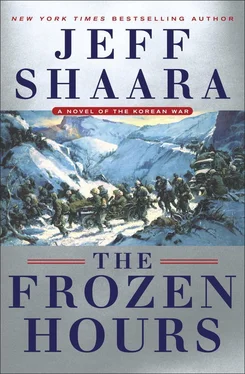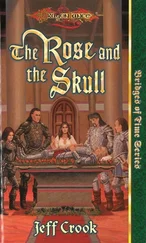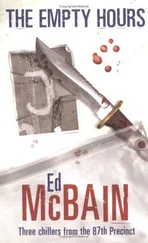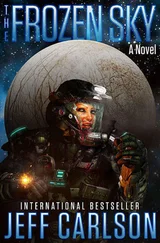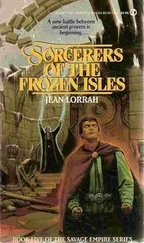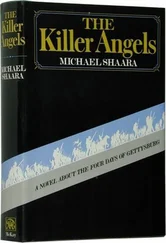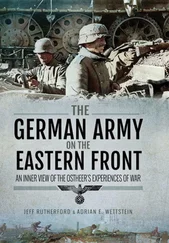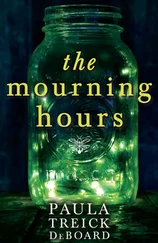To more moderate suggestions that the men should take advantage of their transportation, riding the trucks instead of marching the eleven miles to Koto-ri, Smith understood what many staff officers in Tokyo did not, that packing trucks full of men, allowing them to sit still in frigid conditions, would drain away their ability to react to a crisis. If the journey was uncontested, the far more pleasant ride would make sense. But Smith had to anticipate that the Chinese along that eleven-mile stretch would do all they could to crush the convoy, as they had already done to Task Force Drysdale. Any assumption that the Chinese would simply lie back was erased the first mile out of Hagaru-ri. To arguments that the convoy could make far better speed than the pace of marching men, Smith knew very well that the condition of the road, added to the misery of the weather, meant that speed was a luxury they wouldn’t have. Smith knew that even in decent weather, the trucks would be easy pickings for Chinese mortars and machine gunners, his men crowded together nothing more than ripe targets. Marching among the trucks meant better security for everyone in the convoy.
He had thought of walking with the men, one of those morale boosters that sounded more effective than they truly were. In fact, the business of reorganizing the division, of planning the next phase of the operation, had to be well under way even before the men reached Koto-ri. Chesty Puller had already prepared a large command post for Smith and his staff, and now the engineers were tackling a problem farther down that Smith had anticipated for weeks.
Some three miles south of Koto-ri, the Chinese had finally destroyed the bridge that spanned a deep gorge in Funchilin Pass, creating a major obstacle for the Americans once they began their next drive southward toward Hungnam. Smith was certain the Chinese would fortify the hills around the deep chasm, hoping to crush the Marines and army troops as they bunched up, helpless to move. Smith had to wonder if the Chinese command truly believed the Americans would allow themselves to march full speed toward a nearly impassable roadblock, only to halt in a ten-thousand-man traffic jam while their officers scratched their heads figuring out what to do next. But so far, the Chinese had shown very little imagination in their tactics. By finally blowing the bridge, it was clear to Smith that the Chinese would continue to do what they had done now for weeks, full-on frontal assaults. By creating a difficult roadblock, the location of that assault seemed pretty clear.
The solution to the challenge lay once more with the engineering team led by Colonel John Partridge, the man responsible for the extraordinary success in building the airstrip at Hagaru-ri. This time Partridge was faced with the task of rebuilding the bridge, assisted by the fortunate presence in Koto-ri of a team of army engineers, led by Lieutenant George Ward. Ward had significant experience with the construction of Treadway bridges, prefabricated steel spans, with plywood platforms strong enough to support a tank. The gorge, nearly thirty feet wide, could be bridged easily once the right equipment was brought into Koto-ri. On December 7, while Litzenberg’s men were still fighting their way south, the engineers received a total of eight bridge sections, enough for two full bridges. The spans weighed nearly two tons each and were dropped at Koto-ri by parachute, each span hauled by a C-119 Flying Boxcar. The next task was to clear the pass around the gorge of a formidable force of Chinese whose purpose was to prevent any kind of crossing at all.
KOTO-RI, NORTH KOREA—DECEMBER 7, 1950
“Not sure where we’re going to put them all. I guess I should have paid more attention to just how many people you already had down here.”
Puller drank from a coffee cup, shrugged. “We’ll manage. We’ve got tents ready, mess areas, medical teams. I assume we’re not going to remain here for long. We can certainly supply the men by air as long as we need to, but I’m assuming you’d rather have the men go to the mountain than have the mountain brought up here.”
Smith stared at the map, Puller’s wisecrack slipping past him. “Do we know how strong the enemy is around that bridge?”
Puller sat back, toyed with a half-spent cigar. “Plenty. My suggestion is to send the fresh troops I’ve got here down that way. Chinhung-ni is about seven miles below those hills. I can order my First Battalion there to move north. The enemy will be squeezed from both sides. Won’t matter much how many they are. They can fight for those hills, or die trying. We can grab those hills pretty easily, and once the enemy is out of the way, it’s a clear shot to Chinhung-ni. The convoys can push across the bridge pretty quick, if there’s nobody shooting at them.”
Smith leaned back, one hand on the pipe in his mouth. “Just like that.”
“You don’t agree?”
Smith appreciated Puller’s total confidence, even if there could be a significant cost in casualties.
“How secure is Chinhung-ni?”
Puller stabbed the cigar into his mouth, crossed his arms over his chest. “Right now, my First Battalion is being relieved by some part of the army’s Third Division. That was always the plan. We didn’t really think we’d be bringing everybody back down the same road we went up. You were so fired up about your people being spread out all over hell and gone. Now you’re bitching because we’re all rammed together?”
Smith knew there was nothing angry in Puller’s words, saw the rough hint of a smile. “Lewie, I’m just doing my job. Tenth Corps is going to pick apart every detail of this entire operation. Count on it. If there’s one mistake, my backside is gonna boil for it.”
Now he saw anger, Puller’s expression changing abruptly.
“I won’t put up with that crap, not one bit. There hasn’t been a campaign in any war in history where somebody didn’t hunt up a scapegoat for anything that went wrong. But there’s fifteen thousand, hell, twenty thousand fighting men gathering up in this place who would be happy as hell to tell those mush-brained bastards just what we’ve done here. You didn’t give the orders that got us into this pickle jar. The newspapers, by Christ, they’re telling the American people that this whole outfit is gone, wiped out, and you can believe that Tenth Corps or those morons in Tokyo might still believe that. Or, since we’re doing just fine, thank you, they’re trying to figure out the best way to put perfume on a hog’s ass and lead him in a parade down Fifth Avenue.”
Smith smiled, couldn’t help marveling at Puller’s confused choice of words. “What on earth are you talking about?”
Puller was fuming now, tossed the cigar into a large tin can. “One day I’m gonna run this show. Find a way to keep the damn politicians out of our nose hairs. Your problem, O.P.? You’re a nice guy.”
Smith glanced at the various staff officers, the command post part of an enormous hospital tent. The men had gathered, the junior officers keeping back behind the senior staff. But all eyes were on their commanders. Smith said, “You have work to do, gentlemen?”
Bowser was sitting close by, grinning, his usual expression. “Not really, sir. The boys are still coming in here, and Murray’s people are on the march. Until they complete the trip and we can tally up our casualties, there’s not much else that Colonel Puller hasn’t already done for us.”
Puller kept his arms crossed, grinned past a fresh cigar. “See? Somebody needs to tell MacArthur that Marines aren’t just sons of bitches. We know how to run a war, not just fight one.”
From the far side of the tent, a pair of aides came forward, and Smith looked that way, said, “What is it?”
Читать дальше
